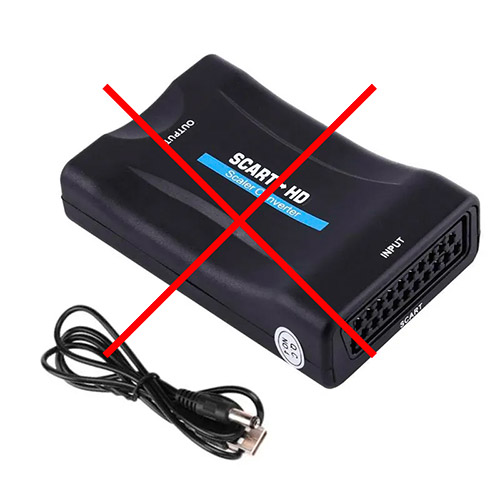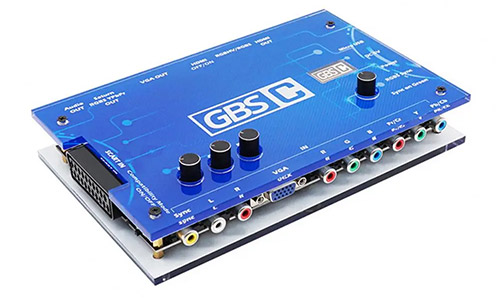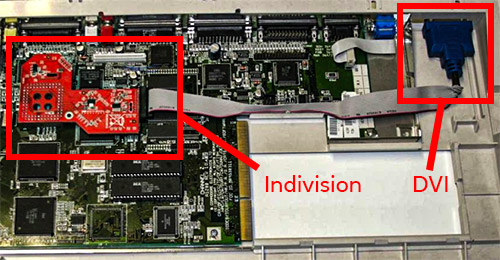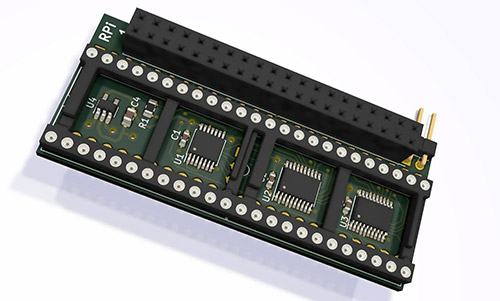Amiga to Modern Display
So you got yourself an old Amiga and you want to dive in.
But ... you don't have an old CRT monitor anymore so ...
How do you connect your Amiga to a modern display?
You've got a few options.
The easiest but Crap
Your Amiga has Composite Video Out.
If it's an Amiga 500 it's monochrome though. for a 600 or 1200, it's in color.
Most TV's still support that. The image quality is terrible.
This might be "good enough" to see if your Amiga works, but we can't recommend it. Read on for some better alternatives.
Still easy and Good
Do you have a TV or a monitor that still has a SCART input? You're in luck: your Amiga is compatible with SCART, all you need is a RGB to a SCART cable.
Don't forget to hook up the audio if you want to have sound through the TV as well.

The road to HDMI
First go to SCART with the cable above, and then go to HDMI with a convertor.
Be sure to use a convertor that supports the RGB pins of SCART.
Basically, you want to avoid cheap passive convertors that look like this.
Convertors that look like this are fine.

"Fine" means: they work and the image quality is OK. Do espect some vertical "banding" though.
These devices are active components that transform the analog RGB signal on the SCART plug to a digital image.
This conversion takes time and introduces "lag".
We are talking about a few miliseconds here. Some people notice it, some don't.
The best - External
if you want better video quality, you'll have to dig deeper in your pocket and spend some moolah.
These devices produce a better quallity image with less lag.
External video convertors are especially handy if you have a lot a retro hardware that you want to connect to modern displays.
There are lot's of options. This one - for example - The GBSC , is not too expensive and still good.
The top of the range is the OSSC, especially useful if you like to have all the configuration parameters of the conversion accessible to play around with.
Expensive but very good.

Our advice: start simple and cheap.
For most people, the thrill of firing up an Amiga and play some old games fades after they notice how slow the bloody thing is and after they notice that 80% of their disks are unreadable.
If you still like your Amiga after the initial high, you can still upgrade your display adapter.
The best - Internal
If you don't want to hassle of bulky external convertor devices that need an additional power supply, you can buy some additonal hardware to upgrade your video-chip to output to HDMI.DVI/VGA.
You will have to open up your Amiga for these.
There are various options, but we can recommend the "Indivision"
They are not cheap but they are plugged directly onto the video chip of the Amiga, bypassing the "digital to analog to digital" step and offering the highest quality video output.
There are various models for each Amiga type. Above is the Indivision AGA mk2 for the amiga 1200.
If you have an Amiga 500, another popular option is a RGB2HDMI apdapter.

These also attach directly to the video chip - Denise - and use a Rasberry Pi Zero to do the conversion to HDMI.
There are not fully "plug-and-play" as they require installing some software on the Pi Zero, and they can be hard to find in stock, but they do offer a super sharp pixel perfect video output.
What about VGA?
Yes, You can by these cheap RGB-2-VGA adapters for your Amiga.

Do keep in mind though, that your Amiga outputs a 15kHz signal by default while most monitors expext a 31kHz signal.
There's a list at https://15khz.net/ with monitors supporting that.
That being said: your Amiga is perfectly capable of outputting a "normal" VGA compatible signal: put your workbench in DbLPAL, Euro72 or Multiscan screenmode and of you go.
(If you can't find them in your preferences, you will need to copy them from Storage/Monitors to Devs/Monitors and do a reboot)
This won't work for games or the boot screen, but at least your workbench can be used like that with any VGA monitor.

High resolution workbench
High resolution workbench with millions of colours used to be the area of big-box Amigas with dedicated graphics cards, but these days that can also be achieved by your "humble" Amiga 500, 600 or 1200 with the help of an accelerator card.
The most popular option is the PiStorm, that lets you use a Raspberry Pi as accelerator and use the HDMI output of the PI to connect you monitor.
Another popular option is the Vampire range of cards from Apollo.
Do keep in mind that these only output the workbench on the HDMI port, as well as other programs that support RTG (Retargetable Graphics)
Normal games and non-RTG software will still output on the default video out of the Amiga.
Big Box Amiga's
Big Box Amiga are more or less made to add expansions cards like graphics cards, allthough most cards are from the "VGA" era.
More recent cards like the ZZ9000 accelerator card offer direct HDMI output.
If you like things traditional and don't want any extra hardware, the Amiga 3000 is the only model with a standard VGA output port with embedded "scan doubler" so it will work with aany VGA monitor out of the box.
Final words
Our advice is again: start small and simple to make sure you actually enjoy your Amiga. You can always upgrade later.
If you're just looking for a nostalgic fix, perhaps more recent emulator devices like the A500 mini are perfect for you: they are plug-and-play and offer HDMI out without the hassle of extra cables and convertor boxes.
